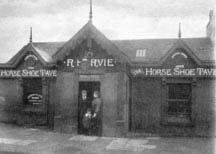Glasgow Road, Half Way.

The Horse Shoe Tavern had an established date of 1804, it succeeded an ancient hostelry giving the place it’s name of Half Way House also known as the Auld Hoose. It was opposite here that the Glasgow to Paisley steam carriage exploded in 1807, the charred remains of the carriage were kept at one time in the Kelvingrove Museum.
The locals bragged that Queen Mary rested and took lunch in here on her way to Crookston Castle. What is certain is that the Harvie family owned this old tavern for generations.
This old building sat on the highway to Paisley and was half way between Glasgow and Paisley. Part of the old tavern was utilised as a smiddy, where many a lucky horse shoe was turned, the smith acting in the double capacity of horse-shoer and Boniface. This was as far back as the time of the great grandfather of Miss Elizabeth Harvie, who was proprietor in the early 1900s. The lease bearing the date 1800 was granted by Lord Blantyre and was for the term of 99 years.
Next to the old tavern, Robert Harvie, Elizabeth’s father, built a two storey house over the smith’s shop as a dwelling house for his son John Harvie, who carried on a large and successful dairy business, supplying most of his products and milk to Govan. Mr Robert Harvie had licensed premises at Williamsburgh, Hawkhead, Paisley and while attending strictly to his own business, he and his brother David efficiently assisted their sister Elizabeth in the management of the Horse Shoe Tavern.
In 1881 Robert Harvie the proprietor of the tavern was living with his large family, he lost his wife at an early age. His dwelling house was large enough to sleep all this children, Elizabeth, 24, John was a joiner aged 27, Robert a blacksmith, 18, James a clerk, 16, William was still at school, 14, David was also at school, 12. Roberts other daughter Mary Stewart was also living in the house with her husband also a blacksmith and their children Walter and Jessie. Robert employed a domestic servant Maggie Martin and a boarder James Broadley a general labourer, he was an old Irish gentleman of 74 years.
The old tavern was demolished in 1901 and a new tenement of houses was erected in it’s place.

